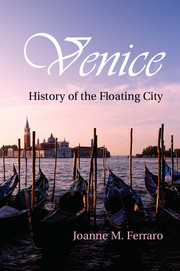Book contents
- Frontmatter
- Contents
- Plates
- Illustrations
- Maps
- Acknowledgments
- Preface
- Chronology of Historical Events
- 1 Reconstructing the Floating City
- 2 The Riches of Asia, Europe, and North Africa
- 3 A Pride of Lions
- 4 Identities and Modes of Socialization
- 5 Material Life
- 6 City of Myth
- 7 The Serenissima’s Wayward Subjects
- 8 The Baroque Stage
- 9 Epilogue
- Appendix I Approximate Population of Venice during the Republic
- Appendix II Population of the Historic Center of Venice, 1871–2010
- Glossary
- Notes
- Bibliography
- Index
- Plate Section
- References
2 - The Riches of Asia, Europe, and North Africa
Published online by Cambridge University Press: 05 August 2012
- Frontmatter
- Contents
- Plates
- Illustrations
- Maps
- Acknowledgments
- Preface
- Chronology of Historical Events
- 1 Reconstructing the Floating City
- 2 The Riches of Asia, Europe, and North Africa
- 3 A Pride of Lions
- 4 Identities and Modes of Socialization
- 5 Material Life
- 6 City of Myth
- 7 The Serenissima’s Wayward Subjects
- 8 The Baroque Stage
- 9 Epilogue
- Appendix I Approximate Population of Venice during the Republic
- Appendix II Population of the Historic Center of Venice, 1871–2010
- Glossary
- Notes
- Bibliography
- Index
- Plate Section
- References
Summary
Crusading Ventures
Venice established the commercial and cultural connections that made it a world city during the three centuries following the first millennium. The remarkable course of maritime expansion began with the establishment of trade agreements with Constantinople, under the leadership of Doge Pietro Orseolo II (991–1008). Throughout the eleventh century Venice cultivated this lucrative alliance, lending critical assistance to the Byzantine emperor in 1082 in his struggle against Norman marauders. Venetian loyalties were in turn richly rewarded with permission to traffic the waters of the eastern Mediterranean.
The renowned Crusades soon followed, creating a series of opportunities for further gain between 1099 and 1204. When the pope galvanized Europe’s restless warriors and pilgrims to reconquer the Holy Land in 1095, Venice became both a pilgrim stop and a point of departure on the way to adventure. The Crusading movement inaugurated the Venetian tourist industry , for the wayfarers required victuals and lodgings during their stopovers. At the same time, Venetian galleys of ered crusaders passage at sea, another lucrative business opportunity. On these expeditions merchants opened up new trade routes in the southern and eastern basins of the Mediterranean. Applying their maritime technology, naval strength, and business acumen, the leading families made Venice a Mediterranean power on equal footing with its former Byzantine rulers.
- Type
- Chapter
- Information
- VeniceHistory of the Floating City, pp. 29 - 50Publisher: Cambridge University PressPrint publication year: 2012



